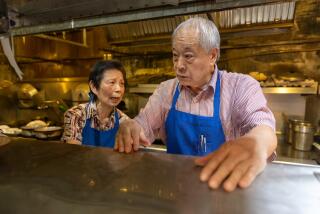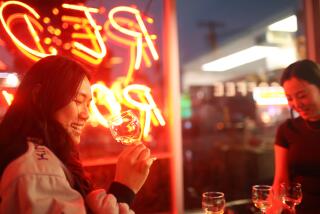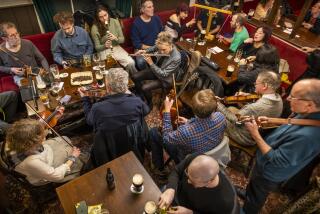For All the Ale in China
- Share via
HONG KONG — The Englishman from Kent was hunched over a wooden table, his fingers grasping a frothing pint of ale. Soccer pennants hung from rough-hewn rafters, and photos of rugby stars covered the walls. The Mersey Sound from the ‘60s drifted from speakers and danced with the cigarette smoke and muted laughter swirling pleasantly around us.
Over in a corner stood the obligatory dartboard, where a couple was in the middle of a spirited game of “301.” To one side, the bartender seemed to change colors whenever he moved under the glare of neon signs pitching Boddington’s Beer, Tetley Bitter, Gaymer’s Olde English Cider and other classic pub delights.
But this wasn’t England.
“This is the only place I know where you can be in another continent simply by walking out the door,” the man from Kent remarked.
One glance out the window revealed a far different world from the one inside this warm room, which felt as if it had been plucked from some rainy little English town and set down steps away from the hustle and bustle of Hong Kong. Just outside, sidewalk vendors were setting up for the night, and the staccato lilt of Cantonese and the aromas from the dai pai dongs--food stalls--mingled with the exhaust of cars and the gentle late afternoon mist.
Pubs are Hong Kong’s most popular expatriate hangouts, true bits of the British Empire in Asia and direct descendants of the lusty bars that once made this city a popular port of call for swabbies in Her Majesty’s navy.
Things are much more civilized now than in the rough-and-tumble days of the 19th century, when this was a wicked naval garrison and a favorite hangout for international racketeers and hustlers. There were brothels and gambling parlors and opium dens everywhere. One census in 1842 counted 439 hookers in 23 houses and 131 opium peddlers in 24 shops. And, of course, there were the public houses (from which the term pub is derived). Some were run by toughened sailors, and some were fabled: the Britannia, the British Queen, the Britain’s Boast, the Eagle, the Waterloo. Drunken brawls were common. In 1842, the colony’s first newspaper, the Friend of China, reported a fight outside a pub called Labtat’s where two sailors stripped to the waist and fought for 83 bloody rounds as a drunken crowd bet on the outcome and the cops made book.
Three years later, the same paper described how “the ruffian Ingood,” who managed a pub, was convicted of robbing drunken sailors and drowning them. Ingood became the first European to be hanged in Hong Kong.
Ah, the good old days. . . .
Much has changed, of course. The British officially left Hong Kong two years ago when China reclaimed it, but the skyscraper-packed metropolis still has deep English influences after 156 years of colonial rule. Visiting pubs is one way to sample this enduring atmosphere.
Normally I don’t hang out in bars, but I like English pubs for their ambience and warmth. Roaming through Hong Kong on many past trips, I would often pass a pub and wonder if it differed from its U.K. cousins.
One evening last February, during a visit with local friends, I announced that I intended to do some serious pub crawling. They laughed.
“That’s a pretty bizarre notion for a nondrinker,” responded my pal Hu. “You’ll drink nothing but coffee, and knowing how much you like to swill the stuff, I’m afraid that the god-awful pub coffee will kill you.”
“If the bartenders don’t kill him first for ordering American coffee instead of tea,” added Hu’s wife, Annie.
So I set off one evening down one of the narrow, stepped “ladder streets” in Hong Kong Island’s Central district for an Irish pub called the Dublin Jack. (I’d save the British ones for later.)
Dublin Jack is an inviting place with a bright red paint job that makes it look like a caboose. I walked in, found a wood-paneled room reminiscent of a ‘70s fern bar, and plopped myself at a table. Soon I was chattering away with a bunch of friendly, homesick expats who come to Jack’s for a taste of home. And the coffee wasn’t bad, either.
Jack’s is divided into three sections: the rustic country pub; the city bar, with stools; and the writer’s bar, a quiet side room full of pictures of Yeats, Joyce and Wilde.
Noel Smyth, a Dubliner who is the pub’s general manager, came to Hong Kong four years ago to run the place. He seemed pleased when I told him how genuine the pub looked.
“Yeah,” he said in a pronounced brogue, “considering where we are. If you look closely, though, you’ll see things you’d never see in a pub in Ireland. Like air-conditioning. In the hot season it runs all the time, even when the fireplace burns. It wouldn’t be an Irish pub without a fireplace.”
The menu would warm an Irish heart. The coddle (Irish sausages, potatoes, bacon and braised onions in a heavy pot) rivals anything I’ve been served on the banks of the Liffey, and the hot brown (wheat bread with slices of turkey, bacon and tomatoes topped with a cheese sauce and browned in the oven) would make a Temple Bar neighborhood pub proud. They’re all prepared by a Chinese cook who carries an Irish passport and speaks with a brogue like Smyth’s.
A few blocks away, in the basement of an office complex on D’Aguilar Street, is the quintessential British pub, Mad Dogs. Named for the Noel Coward quip (only mad dogs and Englishmen go out in the midday sun), the pub looks like a Victorian tavern. It’s dominated by a nautical-looking bar made from highly polished wood, and it’s considered to be one of the most authentic British pubs in Hong Kong.
Opened in 1984, the pub struck a chord with British businessmen who like to lift a glass in familiar surroundings. All the fittings were shipped from the United Kingdom, and posters from England’s colonial days adorn the walls.
Mad Dogs is a mixture of England and Asia, with Yorkshire pudding and bangers-and-mash offered alongside Cantonese sweet-and-sour chicken and Ceylonese curry.
Manager Douglas Moyes, a Hong Kong resident for 10 years, says the menu reflects the pub’s location and its changing clientele. “Since the changeover two years ago, we’ve lost a good chunk of our expatriates. A lot of firms have relocated their staffs.”
Mad Dogs regulars are still about 60% European, he estimates, but the rest are Chinese yuppies who like to stop by for the English food and the often raucous atmosphere. On Monday nights, Mad Dogs is as rowdy as any U.S. bar showing “Monday Night Football.” But instead of sports, the crowd cheers wildly for pub patron contestants playing a cutthroat game of trivia. It’s Jeopardy With an Attitude as a bar employee-host fires off questions. Those answering correctly are given prizes, while the losers become the object of friendly ridicule.
Mad Dogs isn’t a place for eggheads, though. There’s a sports night when soccer and cricket games are broadcast on TV, and on Fridays and Saturdays a deejay spins records and the pub turns into a disco.
In Hong Kong you’ll find pubs for every region of the colonial empire. The Australians hang out at the Kangaroo Pub, while the Scots like the copper-topped bar at the Stag’s Head (formerly the White Stag on Canton Road), both in Kowloon’s Tsim Sha Tsui district.
It was at the Stag’s Head that someone mentioned that if I wanted to see every type of pub in Hong Kong, I shouldn’t miss the Chinnery bar in the super-elegant Mandarin Oriental hotel. “Go see how the other half lives, mate,” my fellow pub patron said. “It’s Hong Kong’s best-kept secret.”
Inside the Chinnery, on the hotel’s mezzanine level, I felt as if I had stumbled into one of the most exclusive gentleman’s clubs in London, and wished I had worn a coat and tie.
Named after George Chinnery, an English portrait painter who worked in Hong Kong and Macau, the place is more a club than a pub. There’s no dartboard here. It’s full of upholstered armchairs and cozy booths with mahogany tables. Chinnery prints hang from the teak-paneled walls, and the whole place is given a golden glow by faux gas lamps.
A large selection of international newspapers and magazines hangs from racks at the entrance, and the whole place reeks of British good manners. I ordered coffee at the mahogany bar and watched the tuxedoed bartender working in front of what’s claimed to be the largest malt whiskey collection in Asia. I mentioned the men’s club atmosphere, and he whispered that some of the members were still miffed because in 1994 women were finally allowed entrance.
The Chinnery is a quiet, staid place where movers and shakers hang out. Its food, luxury snacks such as crab legs and caviar, is first rate, as befits one of the world’s finest hotels. The bar’s specialty, though, is something called the Whisky Trail--shooters with five of the finest--and costliest--Scotch whiskeys, served on a teak board.
The Chinnery prides itself on its whiskeys. It serves the rare Glamis Castle, a single-malt Scotch commissioned for the Queen Mother’s 90th birthday. The bar back holds classics, like a cask-strength Glendullan, a 23-year-old Teaninich and a Royal Brierly in a leaded-glass decanter.
From the Mandarin Oriental, I walked a few blocks to Hartcourt Road near the Wanchai pier. There, at a classic Tudor pub called the Bull & Bear, everything seemed to be jumping, at least compared with the sedate atmosphere at the Chinnery.
According to locals, the Bull & Bear is a Hong Kong institution, built in 1973 by a couple of British expatriates who evidently had successful careers in English vaudeville. It’s now Chinese-owned but run by Britons.
According to Stephen Chan, the pub’s British manager, things here have changed since the changeover. The English waitresses left because of visa problems, and the dartboard is gone, replaced by the ever-popular trivia contests.
The following night, I went to Delaney’s on Tsim Sha Tsui’s Peking Road. I wanted to end my pub crawl in the same type of bar where it began, an Irish pub. Delaney’s is an appealing watering hole where Irish jigs and laughter bounce off the wall as customers drink and feast on Irish stew, corned beef and meat pies.
On Friday nights, local Chinese, British and Irish expats and tourists all dance to a Gaelic band. It’s a happy place where the Queen’s subjects poke good-natured fun at one another.
One joke I overheard made light of Irish and Scots stereotypes. (It can’t be printed here in the interest of good taste.) It was funny, I thought, but as the British roared, the Chinese looked puzzled.
I laughed too, then walked out into the crowded Hong Kong streets and into the noises and smells of a different continent.
(BEGIN TEXT OF INFOBOX / INFOGRAPHIC)
GUIDEBOOK
Into the Drink in Hong Kong
Getting around: British-style pubs are all within easy reach in this compact city, by foot, cab (inexpensive) or on the Star Ferry (about 10 cents).
Where to pub crawl: Kangaroo Pub, 35 Haiphong Road, Tsim Sha Tsui. Chinnery Bar, Mandarin Oriental Hotel, 5 Connaught Road, Central. Delaney’s, Mary Building, 71-77 Peking Road, Tsim Sha Tsui. The Dublin Jack, 37 Cochrane St., Central. Mad Dogs, Century Square, 1-13 D’Aguilar St., Central. The Stag’s Head, 1111 Harts Ave., Tsim Sha Tsui. The Bull & Bear, 10 Harcourt Road, Central.
For more information: Hong Kong Tourist Assn., 10940 Wilshire Blvd., Los Angeles, CA 90024; tel. (800) 282-HKTA (4582), fax (310) 208-1869, Internet https://www.hkta.org.
More to Read
Sign up for Essential California
The most important California stories and recommendations in your inbox every morning.
You may occasionally receive promotional content from the Los Angeles Times.










